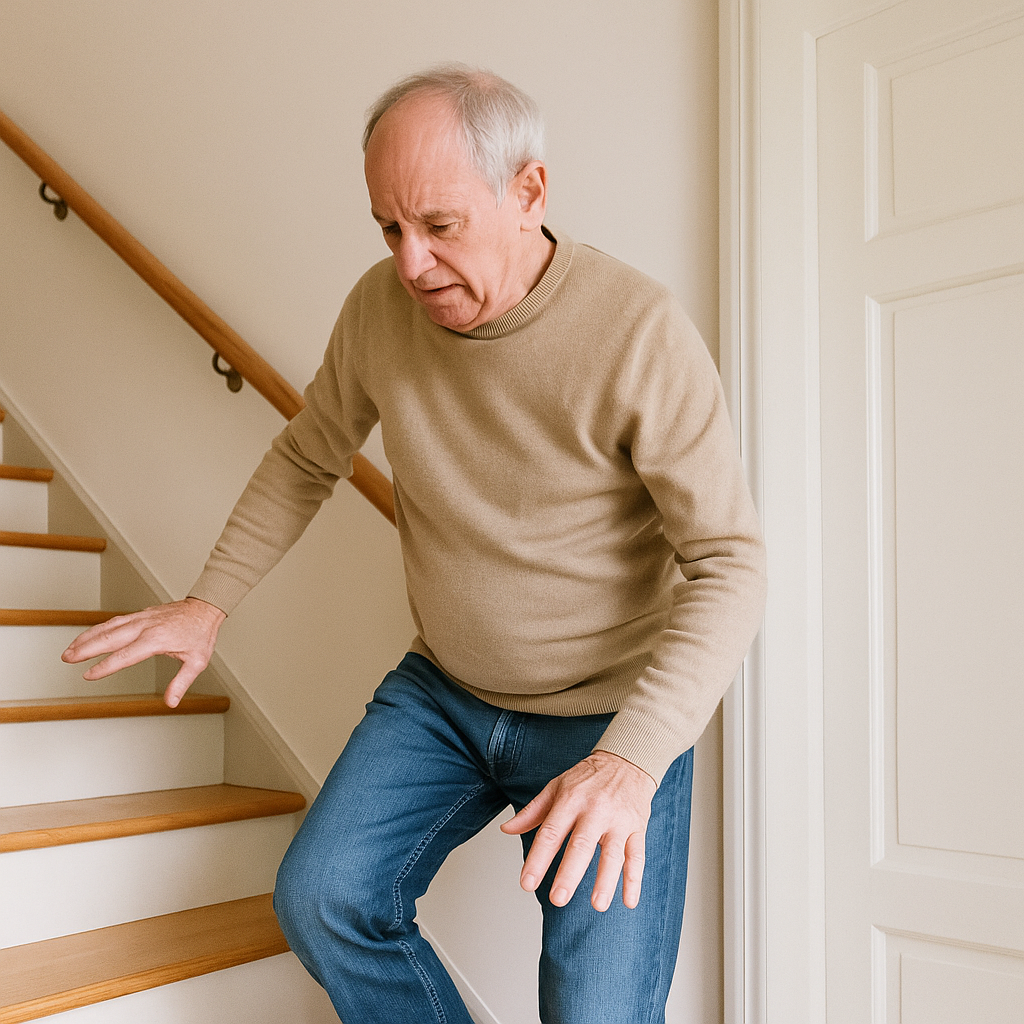A fall can change more than a day — it can change a life. For older adults, even a minor slip can lead to serious injuries, hospital visits, or lost confidence. But here’s the good news: most falls are preventable.
Preventing falls isn’t about fear or limitation; it’s about creating the conditions for freedom with confidence. Every thoughtful choice — from how you arrange your home to the shoes you wear — protects your independence.
🌿 You can’t stop aging, but you can stop preventable falls.
Why Falls Happen
Falls rarely have one cause. They usually come from a mix of small risks that add up over time.
The most common reasons include:
- Poor lighting or shadows on steps and hallways.
- Loose rugs, cords, or clutter in walkways.
- Medication side effects that cause dizziness or fatigue.
- Weak muscles or joint stiffness from inactivity.
- Footwear without traction or support.
- Vision or hearing changes that affect awareness and balance.
By addressing these one at a time, you dramatically lower your fall risk — without needing expensive equipment or major renovations.
1. Keep Your Space Safe and Simple
A cluttered home is a risky home. Start with these easy upgrades:
- Clear floors and pathways of cords, magazines, and extra furniture.
- Use non-slip rugs or remove small rugs completely.
- Add sturdy handrails to both sides of stairways.
- Install grab bars in bathrooms near toilets and tubs.
- Keep frequently used items between waist and shoulder height.
🏡 Every small fix adds up to big peace of mind.
2. Light the Way
Vision changes with age, but proper lighting keeps you steady and confident:
- Add night lights in hallways, bedrooms, and bathrooms.
- Use motion-sensor lights that turn on automatically.
- Keep flashlights or phone lights near the bed.
- Choose warm LED bulbs that reduce glare.
Good lighting isn’t a luxury — it’s one of the easiest and most effective fall preventers there is.
3. Strengthen the Muscles That Protect You
Falls often happen when your legs or core muscles can’t react quickly.
Simple exercises build that protection:
- Sit-to-Stand Repeats: Strengthens legs for daily movement.
- Heel Raises: Improves ankle stability.
- Side Steps or Marching in Place: Enhances coordination.
- Gentle Stretching: Keeps joints flexible and ready to move.
If you’re not sure where to start, ask your doctor for a referral to a physical therapist — they can design a plan just for you.
💪 Every strong step is a fall you won’t take.
4. Choose the Right Shoes
Shoes do more than comfort your feet — they stabilize your whole body.
When possible, wear:
- Flat shoes with firm soles and non-slip treads.
- Adjustable closures like Velcro for secure fit.
- Cushioned support around the heel and arch.
Avoid slippers with open backs, high heels, or smooth bottoms that can slide.
5. Manage Dizziness and Medications
Many prescription drugs can cause lightheadedness or drowsiness — even common ones for blood pressure, pain, or sleep.
Ask your doctor or pharmacist to review your medications regularly.
Also, stand up slowly from sitting or lying down, giving your body time to adjust. A few seconds can prevent a sudden spin or stumble.
6. Stay Hydrated and Eat Well
Dehydration and poor nutrition can both lead to weakness or imbalance.
Drink water regularly, eat protein with each meal, and include potassium-rich foods like bananas or spinach to keep your muscles and nerves functioning properly.
💧 A hydrated body moves with confidence.
7. Keep Your Vision and Hearing Sharp
Schedule eye exams every 12–18 months, and hearing tests as needed.
Even small changes in vision or hearing can affect your sense of balance. Clean glasses often, replace outdated prescriptions, and keep lenses scratch-free.
If you use hearing aids, make sure they fit comfortably and batteries are charged — missing sound cues (like footsteps or doors) can increase risk.
8. Use Support — It’s Strength, Not Weakness
Canes, rollators, and grab bars are tools of independence, not signs of decline.
Use them with pride — they extend your confidence and help prevent accidents before they happen.
Choose supportive aids that fit your height and stride, and replace worn rubber tips regularly.
👣 Balance isn’t about doing it alone — it’s about doing it safely.
9. Check Your Environment Regularly
Conditions change — rugs move, cords reappear, and clutter grows over time.
Every month, walk through your home with a fresh eye:
- Are paths still clear?
- Are rugs secured?
- Are grab bars firm and lighting bright?
A few minutes of awareness can prevent months of recovery.
10. Plan for “What If” Moments
Even with the best preparation, accidents can happen. Having a fall response plan keeps small mishaps from turning into emergencies.
- Keep a charged cell phone or emergency alert device nearby.
- Consider a smartwatch with automatic fall detection.
- Learn how to get up safely after a fall — slowly, using furniture or assistance if available.
Caregivers can add smart home sensors or check-in reminders for extra assurance.
🩺 Preparation isn’t pessimism — it’s protection.
Final Thoughts
Preventing falls isn’t just about safety — it’s about preserving independence, dignity, and peace of mind.
By keeping your body strong, your home well-lit, and your habits mindful, you give yourself the freedom to move confidently every single day.
🌟 You don’t need to walk faster — just smarter.
Recommended Reading
- Stability & Comfort Shoes: Step securely with supportive footwear.
- Safe Movement at Home: Room-by-room upgrades that prevent falls.
- Smart Mobility Technology: Modern tools that enhance safety and confidence.
💬 Frequently Asked Questions
1. What are the best ways to prevent falls in older adults?
Keep pathways clear, improve lighting, and install grab bars or handrails in high-traffic areas. Regular strength and balance exercises, along with supportive footwear, greatly reduce fall risk.
2. Can exercise really help prevent falls?
Yes. Gentle exercises such as Tai Chi, chair yoga, or physical therapy routines build strength and balance. Stronger leg and core muscles help the body react quickly to avoid slips or stumbles.
3. What should seniors avoid wearing to reduce fall risk?
Avoid slippers with open backs, socks without grips, and shoes with slick soles. Choose low-heeled, firm-soled footwear with non-slip traction and proper support.
4. How can caregivers help prevent falls at home?
Caregivers can remove clutter, check lighting, secure loose rugs, and ensure assistive devices are within reach. Encouraging hydration and proper nutrition also helps prevent dizziness or weakness.
5. What should you do if a senior falls at home?
Stay calm. Check for injuries, offer support to move slowly, and call for help if there’s any pain or confusion. Keep a charged phone or emergency alert device accessible at all times.
6. Do medications affect balance or increase fall risk?
Yes. Some prescriptions — especially for blood pressure, sleep, or pain — can cause dizziness or fatigue. Have medications reviewed regularly to identify possible side effects.





